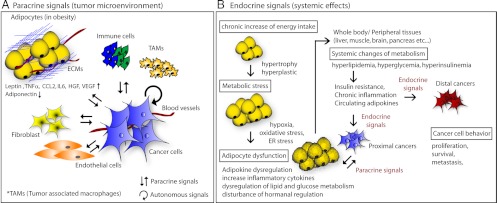Fig. 1.
Paracrine and endocrine interactions of adipocytes with cancer cells. A, Paracrine signals (tumor microenvironment). Both cell-autonomous signals and paracrine signals derived from stromal cells control tumor cell physiology. The tumor microenvironment contains a number of cell types, including adipocytes, fibroblasts, immune cells, tumor-associated macrophages (TAMs), and myoendothelial cells, all of which mediate paracrine signaling in the microenvironment. Adipocytes constitute a key stromal cell type and interact with cancer cells by secreting a variety of signaling molecules that include ECM constituents, adipokines, inflammatory cytokines, and angiogenic factors. HGF, Hepatocyte growth factor. B, Endocrine signals (systemic effects). During the process of adipocyte hypertrophy and hyperplasia associated with the obese state, adipose tissues become dysfunctional due to metabolically challenging conditions, such as hypoxia and oxidative and ER stress. The metabolic consequences of adipose tissue dysfunction, such as adipokine dysregulation, chronic inflammation, dyslipidemia, and hormonal dysregulation, result in insulin resistance. As a result, adipose tissue not only affects proximal tumor cells but also influences distal tumor cell behavior through altered expression of cytokines, insulin, and adipokines.

